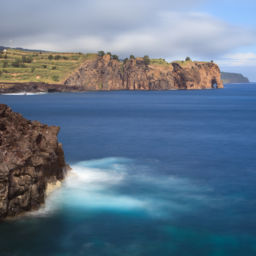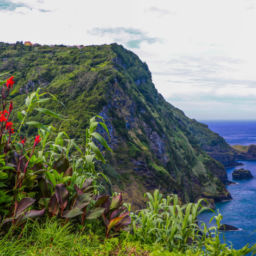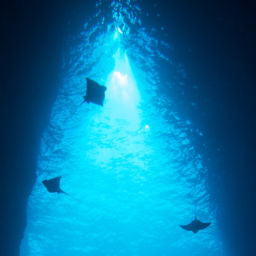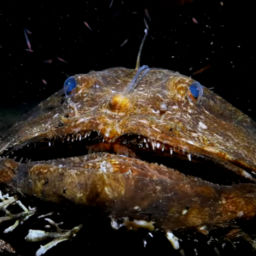All alone in the North Atlantic, 850 miles west of mainland Portugal, are the nine volcanic islands of the Azores. Divided into western, middle and eastern groups, charming Terceira sits right in the middle. An easy 4-hour direct flight from Boston to Terceira puts this exotic-seeming destination within easy reach for a long weekend. One of the larger Azores, the 153-square-mile (397 square km) island is home to around 56,000 inhabitants. Visitors can expect rolling hills covered in farm fields, tidy waterfront villages and friendly residents. Don’t miss the historical center of the Azores’ oldest city, Angra do Heroismo, a UNESCO World Heritage site. The scuba diving in Terceira is also not to be missed.
Arrival on Terceira
After an easy 4-hour flight on Azores Airlines from Boston, my dive buddy (and videographer) and I met our dive hosts for the week, Alex Jacinto and Rita Nogueira, owners of Octopus Diving Center in Praia da Vitoria, home base for the next few days. This quiet, seaside town has a wide stretch of beach, pretty cobblestone streets lined with whitewashed houses, and small plazas featuring colorfully painted churches.
After checking into our basic but comfortable rooms, Alex and Rita gave us a lift to the dive shop, only about a 10-minute walk from our hotel. Anxious to start diving, we headed straight out to Cinco Ribeiras, a shore dive about 30 minutes from Praia on the southwest coast.
Scuba Diving in Terceira
The high season for Octopus Diving Center runs from mid-May to October, so our July visit was perfectly timed. On our way to Cinco Ribeiras, we chatted about conditions. Water temperatures run from 64 F (18 C) in July to 75 F (24 C) in August, and back down to around 64 F (18 C) in October. Divers wear anything from a 7mm wetsuit to a drysuit. I opted for the most neoprene I could squeeze into and went with a 7mm wetsuit and farmer John atop. We got to the shore — where there were a bunch of hardy kids swimming in the chilly water in just swimsuits — suited up, and strode into the sea about six feet below.
This sweet little site didn’t disappoint. We saw schooling salema and baitfish, rockfish, a conger eel, lots of shrimp, flounder and scorpionfish. With the shoreline to the right, we came to a small swim-through tunnel. You needn’t be cave certified, as light is always visible. Cutting through the rock, the tunnel exits into the blue, from whence we turned around and headed back.
Not bad for our first Terceira dive, and our second dive at Coral Valley was just as good. After about a 10-minute boat ride from Praia da Vitoria, we arrived at a small inlet called lhéu do Norte and dropped in to about 70 feet (21 m). Keeping the wall to our right, we approached a valley in the rocks, filled with a field of as-yet-unnamed white, red and brown soft coral growing an abundance. The prolific baitfish, slipper lobsters, rockfish, scorpionfish, barracuda and passing eagle ray rounded out the dive.
At Bat Ray Cave (Gruta do Ilheu das Cabras) the next day, we were promised schools of bat rays, and bat rays we had. With over 50 feet (15 m) of vis, we descended to about 53 feet (16 m) just outside the entrance to a small cave on Ilhéu das Cabras, an uninhabited spit off Terceira. As we entered the cave, we took care not to spook the bat rays hiding inside. We swam to the back of the cave and then turned around for the dive’s real draw: a picturesque view of the bat rays, swimming lazily out of the cave silhouetted by its entrance and the deep blue sea beyond.
On our final dive day, we visited the Underwater Archaeological Park in the bay of Angra, and home to the wreck of the Lidador. Another shore dive, this one’s exceedingly shallow at just 25 feet (8 m). It’s also a great spot for night dives or underwater photography. Built in London in 1873, the 256-foot-long (78 m) Lidador was an iron-hulled steamer that sank here in 1878 due to a deadly southeast wind that pushed the ship into a reef. Today it lies on its side about 165 feet (50 m) from shore and is home to lots of small reef fish, as well as at least one especially friendly octopus, which seemed as curious about us as we were about it, following us around for almost the entire dive.
Whale Watching
One afternoon we decided to search for marine life topside instead of underwater, and joined Ocean Emotion on one of their popular whale-watching tours. The Azores is famed for its year-round population of sperm whales, but up to 27 species of whales are in the surrounding waters at any given time. Drawn here by the warm, nutrient-rich currents, the Azores is a kind of rest-stop for migrating whales, especially during the summer phytoplankton bloom. They stop to feed and rest before heading on their way. After a briefing from a marine biologist, boats depart from the Angra Marina. The three-hour tour offers a near guarantee that you’ll spot whales or dolphins year-round.
Although we didn’t get lucky when it came to whales, spotting only the backs of a few fin whales as they descended after taking a breath, spotted dolphins made more than one appearance, using the boat’s wake to surf and show off their acrobatic moves.
Topside on Terceira
Much of the island’s interior is a nature reserve, and the best way to see it is via rental car. On our final afternoon, we drove from Praia to Angra do Heroismo, meandering briefly around the walkable cobblestone streets of this ancient town, founded in the latter part of the 15th century. Just over 35,000 residents call this UNESCO World Heritage site home today, and the streets and plazas are well worth a wander, as well as the harbor, which features a few chic waterfront restaurants, the perfect stop for a cappuccino or glass of wine.
From there it was on to Algar do Carvao, or Carvao Cave, in the middle of the island. This 300-foot (90 m) deep volcanic pit formed over 3,000 years ago when magma drained from the volcano’s main chimney into the magma chamber. In 1893, two brave Azoreans lowered themselves to 147 feet (45 m) using a bullfighting rope. But it wasn’t until 1963 that locals explored the entire cave. It opened to tourists in 1968, who now traverse 338 steps down from the entrance to the bottom. The cave’s cool walls are covered in moisture, moss and ferns. At the bottom of those many steps await, a rainwater lake and the airy Cathedral, hung with shimmering stalactites.
Our topside adventure at an end and with our dives behind us, we headed home the next morning. Our four days on Terceira were just enough to offer a refreshing summer escape to a lovely locale, exotic but easy-to-reach. As I boarded my flight back to Boston, I wondered why it had taken me so long to visit the Azores, and swore it wouldn’t take me so long to return.
Where to Stay
Because we wanted to be close to the dive center, we stayed in Praia da Vitoria at Hotel Teresinha. It’s in the center of town and just a few minutes’ walking distance from Octopus. Although nothing fancy, the rooms were comfortable and clean. There’s also a small breakfast buffet to get your day started right. If you’re staying in Angra or want somewhere beachfront, try any of the accommodations listed here.
Where to Eat
There are a few tasty spots around the island. Our two favorites were within walking distance of the hotel and dive shop. Although neither my dive buddy nor I eat fish, we made multiple visits to Restaurante O Pescador, tucked onto a cobblestone side street in Praia. They’ve got plenty of options for non-pescatarians; we loved the veggie paella. If you do eat fish, try to stick to locally caught items. Don’t skip dessert — the chocolate fudge brownie with ice cream is fantastic.
Our other favorite spot in Praia was Bio Azorica. This small café and market offers daily vegan and vegetarian specials. There are also desserts, homemade bread, local produce and a small selection of grocery items.
How to Get There
Airlines from both mainland Portugal as well as the East Coast of the U.S. serve Terceira well. Azores Airlines offers direct flights to Terceira from Boston year-round.




















